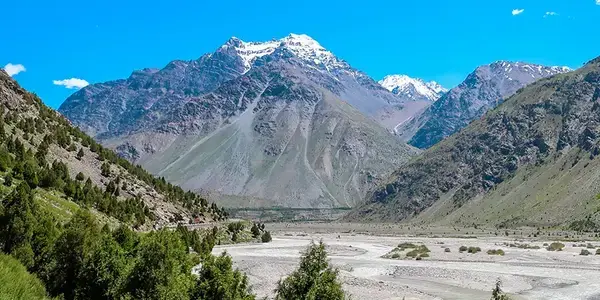


Deepak Tal, a tranquil high-altitude lake located at approximately 12,500 ft, is a lesser-known gem in the Lahaul region of Himachal Pradesh. It sits quietly beside the Leh–Manali Highway, a few kilometers before Jispa, and is often visited by travelers heading toward Ladakh.
Unlike other high-altitude lakes, Deepak Tal hasn’t been commercialized and remains untouched by mass tourism. The lake is fed by glacial melts, and its crystal-clear waters reflect the nearby snow-capped peaks, offering a mirror-like view that feels almost surreal. Locals say the name “Deepak Tal” was given due to the ...

Places To Visit In Lahaul Valley
Top places to visit in Lahaul Valley.
.webp)
Images Of Lahaul Valley
Experience Lahaul’s raw landscapes, mountains and villages through images
Places To Visit In Lahaul Valley
Images Of Lahaul Valley
Windproof Jackets & Layers
The area is cold even during daytime, especially if windy. Carry light jackets, thermal inners, and warm accessories.
Sunglasses & Head Cover
The reflection off the lake and snow can cause eye strain. Keep your head and eyes protected from both sun and chill.
No Need for Full Acclimatization
The lake's altitude is not extreme, but still take it slow if you're coming directly from Manali.
Carry Basic AMS Prevention Kit
Even though it’s a lower stop, always have Diamox, painkillers, ORS, and personal meds handy during the journey.
Photography & Selfies
Take panoramic shots of the still lake reflecting surrounding peaks—best before 9 AM.
Relax by the Water
Sit on the rocks or by the road, dip your fingers into the icy water, and enjoy the sound of wind and silence.
Picnic Stop
Many travelers bring light snacks and enjoy a peaceful lakeside picnic before heading to Baralacha La.
No Shops at the Lake
Bring your own snacks or stop at nearby dhabas in Jispa or Zing Zing Bar for food and chai.
Carry Hydration & Dry Fruits
Staying hydrated is important at altitude. Carry sippers, nuts, and energy bars to avoid fatigue during long drives.
May to October offers calm weather and clear reflections.
Deepak Tal, a tranquil high-altitude lake located at approximately 12,500 ft, is a lesser-known gem in the Lahaul region of Himachal Pradesh. It sits quietly beside the Leh–Manali Highway, a few kilometers before Jispa, and is often visited by travelers heading toward Ladakh.
Unlike other high-altitude lakes, Deepak Tal hasn’t been commercialized and remains untouched by mass tourism. The lake is fed by glacial melts, and its crystal-clear waters reflect the nearby snow-capped peaks, offering a mirror-like view that feels almost surreal. Locals say the name “Deepak Tal” was given due to the way it gleams like a lamp ("deepak") under sunlight.
Historically, the area around Deepak Tal was used as a grazing stop for locals moving their herds across the valleys. Today, while there's not much historical structure nearby, the lake has grown in popularity among bikers and road trippers for its peaceful vibe and photographic beauty. With the rise of sustainable and slow travel, Deepak Tal is now seen as a must-stop point—not for activities, but simply for stillness and silence in the middle of a dramatic Himalayan drive.
Natural Glacier-Fed Lake
Deepak Tal is formed from glacial meltwater, which gives the lake its crystal-clear appearance and icy blue color.
Accessible Without Trekking
Unlike most Himalayan lakes, you can simply drive right up to Deepak Tal, making it ideal for short halts without a trek.
Photography Spot
Its still waters create beautiful reflections of the surrounding peaks—perfect for early morning or golden-hour photography.
Safe for Quick Halts
The altitude here is manageable for most travelers, so it's a great place to stop without worrying about acclimatization issues.
Peaceful with Minimal Crowds
Since it's often skipped for bigger destinations like Baralacha La, you can enjoy quiet moments without tourist rush.
The Morning Mirror Tale
A travel vlogger once visited Deepak Tal at sunrise and captured a rare moment: the lake was completely still, and the mountains reflected so perfectly that the video went viral. Locals began calling it “the morning mirror,” and soon travelers started planning early departures from Jispa just to witness this reflective magic. The video helped Deepak Tal gain visibility as a peaceful stopover, reminding travelers to pause, breathe, and soak in the silence of the Himalayas.
The Biker's First Breath
A first-time Ladakh biker shared his emotional moment at Deepak Tal—it was his first encounter with true Himalayan scenery. After hours of riding uphill, seeing the calm lake made him stop, dismount, and sit silently for over an hour. It became his personal spiritual checkpoint, where he "left the plains behind and entered the mountains." He revisits every few years to reconnect with that feeling, calling Deepak Tal his first true Himalayan breath.
A valley is a low-lying area between hills or mountains, often formed by the erosion of water or glaciers. Valleys are characterized by their U-shaped or V-shaped profiles and can contain rivers, streams, and fertile land.